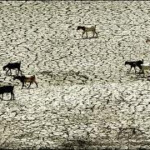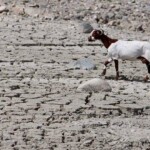More than half of Cyprus? territory is at risk of desertification, the European Court of Auditors (ECA) said on Wednesday. The ECA announced that Cyprus is included in an audit of the EU?s plans to combat desertification to examine whether the risk is being effectively and efficiently addressed. ECA auditors are to visit Cyprus, which, along with 12 other EU member states, has declared itself to the United Nations Convention to Combat Desertification (UNCCD) as affected by desertification. They will also visit Romania, Italy, Spain and Portugal. According to the UNCCD, desertification is ?land degradation in arid, semi-arid and dry sub humid areas resulting from various factors, including climatic variations and human activities?. Desertification is both a result, the ECA said, and a cause of climate change. ?It also results from unsustainable land management practices. It magnifies climate change, as desertified land loses its capacity to stock carbon, so lower volumes of greenhouse gases can be absorbed.? According to Cyprus national action programme to combat desertification, 57 per cent of the territory ?is in a critical situation with regard to the risk of desertification?. ?Desertification can lead to diminished food production, soil infertility and a decrease in the land?s natural resilience and ability to store carbon,? said Phil Wynn Owen, the ECA member responsible for the audit. ?These in turn can cause poverty, aggravated health problems due to wind-blown dust and a decline in biodiversity. It can result in loss of livelihoods, which can cause the affected people to migrate.? The ECA said that soil erosion, combined with water shortages and higher temperatures which increase evaporation, further increases the risk of desertification. ?The situation is most serious in a large part of Spain, southern Portugal, southern Italy, south-eastern Greece, Cyprus and areas of Bulgaria and Romania bordering the Black Sea.? It added that research indicates that up to 44 per cent of Spain, 33 per cent of Portugal, and nearly 20 per cent of Greece and Italy are at high risk of soil erosion. The audit report is expected to be published by the end of 2018, as well as an audit on flood risk management in the EU. The ECA said that EU funding for desertification projects comes from a variety of sources, such as the European Agricultural Fund for Rural Development, the LIFE Programme and the EU?s research programmes. Cyprus Mail - 1st February 2018
Water levels in reservoirs in Cyprus are desperately low and weather forecasts show no signs of that changing, acting director of the Water Development Department Nicos Neocleous said on Monday. Speaking on state radio, Neocleous said the entirety of water held in reservoirs across Cyprus is 63 million cubic metres, a mere 21 per cent of total capacity. Reservoirs connecting to the Southern Conveyor ? Cyprus? largest water supply network ? contain only 27.7 million cubic metres, or 14.6 per cent of capacity, compared to last year?s 56.4 million cubic metres. Last year, Cypriot reservoirs held twice this quantity. ?The situation is comparable with the 2008 drought, when the Cyprus government had arranged for water to be transported to Cyprus [from Greece] on tankers,? Neocleous said. ?Thankfully, we now have four desalination plants, which produce a total 220,000 cubic metres of water daily, covering the supply needs of Nicosia, Limassol, Larnaca, and Famagusta.? The bleakest outlook is in the Paphos area, which has 26 million cubic metres of water in its reservoirs, short of the annual requirement of 28 million for the region. ?Unfortunately, Paphos is not covered by a desalination unit, but we plan to take a proposal to the cabinet for a permanent unit in Paphos,? the water department boss said. ?Of course, there has been a desalination plant there since 2008, but it has to be removed as the contract with the operator has expired. We have tried to get the contract extended, but the Legal Service said it is illegal and must dismantled by year-end.? The mobile desalination unit was installed in the wake of the 2008 drought but almost never used as Paphos? water needs were soon met by supply from the Asprokremmos dam. The contract signed with the private company which owned the unit, provided that the government would buy water at ?1.21 per cubic metre. It was also agreed that the company would be compensated for the time the unit was inactive. The unit operated only for a short period of time but after maintenance work was carried out at the Asprokremmos reservoir, the unit remained mostly inactive. For the last year there had been thoughts whether the government should buy the unit but the option was deemed cost-inefficient. Necleous said water depletion in reservoirs will likely cause other problems than the obvious one of water shortages. ?The less water is in the dams, the poorer its quality,? he said. ?Also, the less water there is, the less likely it is that fish in the dams can survive as there is less oxygen. We haven?t gotten to this point yet, but we are in contact with the fisheries department to move some of the fish if we do get there.? Weather forecasts aren?t very hopeful. ?For the next five or six days there is no rain forecast,? Neocleous said. ?It?s a difficult situation. We call on the public to conserve water as much as possible. The real question is what will happen to agricultural irrigation needs next year, if things don?t change.? According to Neocleous, Cyprus? largest reservoir ? Kourris ? now holds 12.8 million cubic metres of water, or 11.2 per cent of its capacity. The Kalavasos reservoir has 2.8 million cubic metres, or 16.8 per cent. Arminou holds 23 per cent of capacity, Asprokremmos 40 per cent, and Yermasoyia is in tragic shape with just 5 per cent. ?It is expected that Yermasoyia will empty next month, which will give us a chance to do some maintenance work,? Neocleous said. Cyprus Mail - 11th October 2016







